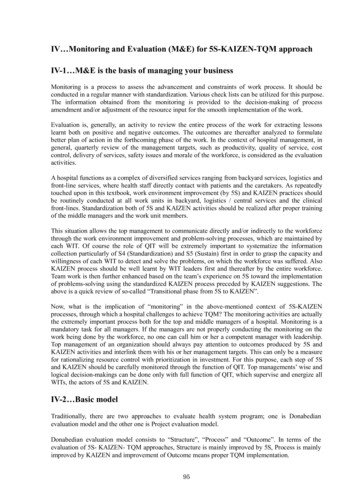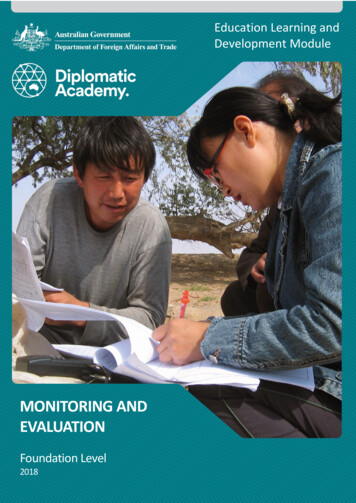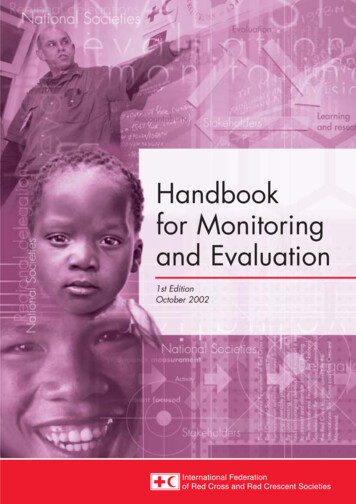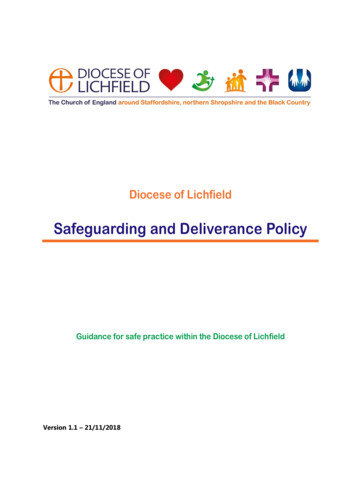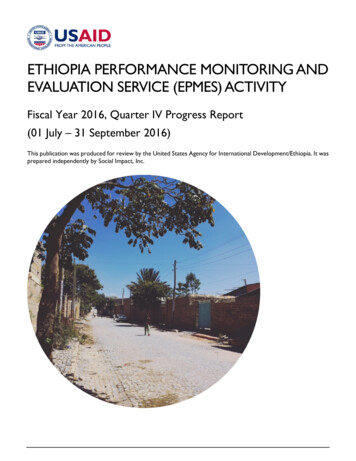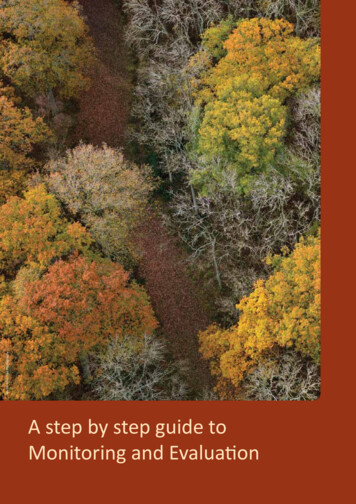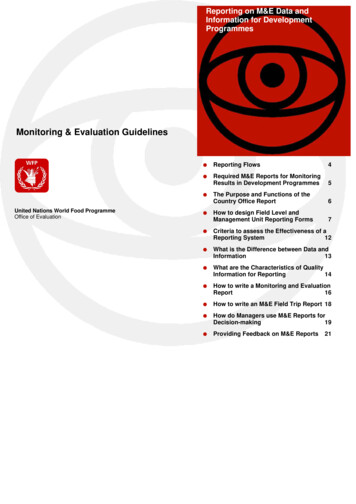
Transcription
Reporting on M&E Data andInformation for DevelopmentProgrammesMonitoring & Evaluation GuidelinesUnited Nations World Food ProgrammeOffice of Evaluation Reporting Flows4Required M&E Reports for MonitoringResults in Development Programmes5 The Purpose and Functions of theCountry Office Report6 How to design Field Level andManagement Unit Reporting Forms7 Criteria to assess the Effectiveness of aReporting System12 What is the Difference between Data andInformation13 What are the Characteristics of QualityInformation for Reporting14 How to write a Monitoring and EvaluationReport16 How to write an M&E Field Trip Report 18 Providing Feedback on M&E ReportsHow do Managers use M&E Reports forDecision-making1921
GuidelinesReporting on M&E Data and Information for Development ProgrammesOverviewIntroduction. The purpose of this module is to specify the characteristics and roles ofM&E reports as tools to convey quality information about operations’ results todecision-makers.Why is this Module important?At the planning and inception stages of operations it is important to set out the types andcontent of the M&E reports that will be required and to clarify how they will be used. This helpsplanners to determine the minimum information requirements and to streamline reporting formsaccordingly. During operation implementation, M&E staff need to ensure that they collect andpresent M&E information in concise and complete reports that facilitate stakeholders andmanagers to make timely and relevant decisions.What does this Module aim to achieve?This module has the following objectives: To describe the reporting flows relevant to M&E.To identify and describe the reports required for monitoring results in developmentprogrammes.To describe the purpose and functions of the Country Office Report.To provide guidance on how to design field level and management unit reporting forms.To describe 5 criteria to use to assess the effectiveness of a reporting system.To define the difference between data and information.To describe the characteristics of quality information for M&E reporting for decision-making.To provide guidelines for writing M&E reports.To describe the main content and layout for an M&E field trip report.To describe how managers use M&E reports for decision-making.To describe the importance of providing feedback on M&E reports.What should be reviewed before starting? How to design a Results-Oriented M&E Strategy for Development ProgrammesSection Titles and Content Headings Reporting FlowsIntroductionReporting Flows within Country Offices and from the Field to HQRequired M&E Reports for Monitoring Results in Development ProgrammesIntroductionRequired Reports in Development ProgrammesThe Purpose and Functions of the Country Office ReportIntroductionPurpose and Function of the Country Office Report 2
Guidelines How to design Field Level and Management Unit Reporting FormsIntroductionGuidelines on Reporting FormsAn Example of a Health Activity Initial Data Collection Form and Subsequent LevelReporting Formats for the MCH Activity in YemenCriteria to assess the Effectiveness of a Reporting SystemIntroductionCriteria to assess the Effectivenes of a Reporting SystemWhat is the Difference between Data and InformationIntroductionDefining Data and InformationAn Example of Data and InformationWhat are the Characteristics of Quality Information for ReportingIntroductionWhat does ‘Quality’ Information ImplyGuidelines for ensuring High Quality InformationAn Example of Good Quality InformationAn Example of Poor Quality InformationHow to write a Monitoring and Evaluation ReportIntroductionGuidelines for writing M&E ReportsAn Example of a Table of Contents for an M&E ReportHow to write an M&E Field Trip ReportIntroductionGuidance on writing an M&E Field Trip ReportAn Example Format for a Field Trip ReportHow do Managers use M&E Reports for Decision-makingIntroductionM&E Reports as Decision-making ToolsHow Different M&E Reports are used by ManagersAn Example of how Specific M&E Reports are used in Development OperationsAn Example of the Use of M&E Reports in Stakeholder Reviews for EMOPsProviding Feedback on M&E ReportsIntroductionGuidelines for providing Feedback on ReportsExamples of Formal Feedback Opportunities to be stated in the M&E Plan 3
GuidelinesReporting FlowsIntroduction. This section describes the reporting flow by which monitoring andcountry office based evaluation information is transmitted to inform managementdecisions.Reporting Flows within Country Offices and from the Field to HQThe following diagram outlines the flow of key reports for EMOP, PRRO, and Development operations. Timely information flow is critical for using monitoring and evaluating information to inform decision-making in operations. For operations in which partners are responsible for a significant amount of M&E data collection and reporting, WFP has a role to play in assessing the reliability and accuracy of the partner’s reports at both field and country levels.The Relationship between the different WFP Monitoring Reports4
GuidelinesRequired M&E Reports for Monitoring Results in DevelopmentProgrammesIntroduction. This section identifies and describes the reports required for monitoringresults in development programmes.Required Reports in Development ProgrammesThe basic reporting system for Country Programmes and Activities is as follows:Regular Field Reports – Most Activities are implemented by government or by implementingpartners. For their own internal management purposes they produce regular monitoring reports(usually monthly and quarterly). The format and contents of these reports varies according tothe type of Activity, the availability of data, and the capacity of the implementing agency to collect and process data. Formats and responsibilities for these reports are agreed during Activitydesign, and are set out in the Operational Contract.The Quarterly Project Report (QPR) – The QPR is prepared every 3 months by the government and implementing partners and submitted to the country office, for which it is an essentialmanagement tool. Part A covers commodity tracking, Part B gives tabulated numbers of beneficiaries (disaggregated by sex) and work or feeding days, and Part C covers LTSH costs. Thesereports should include information on outputs as agreed in the M&E Plan.The Project Implementation Report (PIR) – The PIR is prepared by government and implementing partners. It is submitted, normally, to the country office every 6 months. The nature andcircumstance of the operation may affect its timing. For instance, it may appear in time withschool terms. The PIR is primarily a record of physical achievements or outputs, but it shouldalso include information on outcome indicators. It is essential that the Activity’s monitoring planspecifies the sources of the PIR's information, and its flow. The format and contents of these reports vary according to the type of Activity, the availability of data, and the capacity of the implementing agency to collect and process data. Formats and responsibilities for these reports areagreed during Activity design and are set out in the Operational Contract. The PIR should include information on progress towards outcomes based on Beneficiary Contact Monitoring, conducted by the government or implementing partner field staff. The PIR should be consistent withthe M&E plan and therefore may require review and updating on an annual basis.The Country Office Report – The COR is prepared every 6 months for each Activity by the responsible WFP Officer. Individual Activity CORs will be summarised in a Country ProgrammeCOR that will be sent by the Country Director to the Regional Bureau. The report provides a record of Activity/Programme implementation with factual information on activities (food delivery),outputs (people fed and assets created), and outcomes (improved nutrition, stable livelihoods).The COR includes a rating system by which the Country Office judges the progress of eachActivity and the Country Programme towards achievement of its planned targets. The COR includes both statements of any problems currently affecting the Activity and recommended solutions. It also provides a basis for tracking if identified follow-up actions have been undertaken.5
GuidelinesThe Purpose and Functions of the Country Office ReportIntroduction. This section describes the purpose and function of the Country OfficeReport (COR) required by development programmes, EMOPs and PRROs.Purpose and Function of the Country Office ReportThe purpose of the Country Office Report is to monitor and evaluate performance at the operation level. It is a standard tool to examine progress, solve implementation problems and, at theappropriate stage, evaluate performance and impact against design. Its purpose is to help improve the effectiveness of WFP’s operations. It aims to reinforce the Results Based Management principles. The development of the report format is based on the Country Office ProjectReport, introduced in 1991, but the new format has been extended to cover all WFP operations.The Country Office Report performs the important functions of:1. Informing staff at Country Office, Bureaux and Headquarters of the current status of (i)Development Activities, whether stand alone or within Country Programmes, (ii) EMOPs,(iii) PRROs and (iv) Special Operations.2. Providing a record of implementation with factual details on inputs (funds, food supply),outputs (people fed and assets created) and outcomes (saved lives, improved nutrition,stable livelihoods).3. Assessing performance through comparing planned results with those actually achieved,and by using a standardised rating system to compare progress between different operations, sectors, countries and types of operation.4. Measuring the effects of the operation on the target beneficiaries, and thereby allowingWFP at country, region and corporate level to gauge its success in attaining outputs andpurposes, and to report these to the Executive Board, donors and other stakeholders.6
GuidelinesHow to design Field Level and Management Unit Reporting FormsIntroduction. This section provides guidance on how to design field level andmanagement unit reporting forms, both for WFP and for partners.Guidelines on Reporting FormsFor many operations the reporting forms at each level in the reporting chain, from initial routinedata collection to synthesis of data at district and provincial levels, contain a significant proportion of the overall monitoring information. The purpose, contents and use of the report formmust be clear to monitoring and management staff at all levels both within WFP and the implementing partner.Below is a ‘To-Do’ Checklist on how to develop and implement reporting forms.Use clear language, sufficient space and attractive layout whenever possible.Build on existing systems Harmonise the layout of reports Present items in the same order, use the same layoutfor specific items and include items which can becopied from one report to the other.Test all reporting forms before finalisation and printing Ensure that users understand how to use them.Make reporting forms easy to fill inDistribute reporting forms in sufficient numbers and ontime Provide for file copies that be kept at operation sites orby district coordinatorsAgree formally with all major implementing partners onthe reports to be submitted to WFPMake provision for technical assistance and trainingTake account of the management culture, local traditions and work procedures.Use local terminology and adapt the layout of monthlyreports to other reporting forms used by the government or implementing partner to ensure their familiaritywith the reporting style.Encourage field level staff to maintain and use theircopies of the reports for monitoring progress and takingdecisions.Reporting forms can be printed on self-copying paperso that copies are automatically generated as the original is filled in. Encourage monitoring staff to consult copies of reports(kept in plastic folders) during field visits. Ensure that relevant government, implementing partnerand WFP staff are trained in the use of reporting forms.Samples of reporting forms should be included and reporting obligations should be clearly outlined in allMOUs, LOUs and operational plans.An Example of a Health Activity Initial Data Collection Form and SubsequentLevel Reporting Formats for the MCH Activity in YemenThe first form is for use by MCH centres in reporting monthly data to districts. To summarisehealth centre forms districts use the second form. Notice that there is additional district leveldata on training to be added that does not come from the centres. The second form is then sentto the Ministry of Health.WFP and Government of Yemen MCHSection 1Monthly Monitoring FormCenter information[ Instructions : answer each month ]7
GuidelinesWFP and Government of Yemen MCHMonthly Monitoring Forma. Name ofMCH Centerb. Villagec. Districtd. Governoratee. Name ofHealth CenterDirectorf. Name andsignature ofperson fillingformg. DateSection 2Patient Status and Food Receipts[ Instructions : Answer Each Month for all patients elegible to receive WFPfood ]Total Number of Eligible Patients by CategoryMaleFemaleTotala. Children under 5 attendingMCH clinic/unit this monthb. Children under 5 malnourished (underweight weight/age)c. Children under 5 with entryon growth monitoring chart thismonthd. Children under 5 with weightgain this month compared tolast (GMC)e. Children under 5 with noweight gain or loss this monthcompared to last (GMC)f. Children under 5 with firstgrowth monitoring chart entrythis monthg. Pregnant Women attendingMCH clinic/unit this monthh. Pregnant Women less than 52kgs at 6 monthsi. Pregnant Women with weightgain this month compared tolastj. Pregnant Women with weightmonitored this month and lastmonthk. Pregnant Women receivingfull food package/ration thismonthl. Pregnant Women receivingSectionial food package/rationthis month8
GuidelinesWFP and Government of Yemen MCHMonthly Monitoring Formm. Children under 5 receivingfull food package/ration thismonthn. Children under 5 receivingSectionial food package/rationthis monthSection 3Food distribution, Losses and Stores[ Instructions: Answer each month regardless of whether food was received or not ]WheatOilSugarWSBa. Food balance from last month(in Kgs)b. Food received this month (inKgs)c. Food distributed this month(in Kgs)d. Food losses this month (inKgs)e. Current food balance (in Kgs)WFP and Government of Yemen Health ProjectSection 1Monthly Monitoring FormCenter Information[ Instructions : Answer Each Month ]a. Governorateb. Name of Governorate Project Managerc. Name and signature of person filling formd. DateSection 2MCH Patient Status and Food Receipts[ Instructions: Answer Each Month by summing Health Center forms ]Total Number of Eligible Patients by Category1MaleFemaleTotala. Children under 5 attendingMCH clinic/unit this month9
GuidelinesWFP and Government of Yemen Health ProjectMonthly Monitoring Formb. Children under 5 malnourished (underweight weight/age)c. Children under 5 with entryon growth monitoring chart thismonthd. Children under 5 with weightgain this month compared tolast (GMC)e. Children under 5 with noweight gain or loss this monthcompared to last (GMC)f. Children under 5 with firstgrowth monitoring chart entrythis monthg. Pregnant Women attendingMCH clinic/unit this monthh. Pregnant Women less than 52kgs at 6 monthsi. Pregnant Women with weightgain this month compared tolastj. Pregnant Women with weightmonitored this month and lastmonthk. Pregnant Women receivingfull food package/ration thismonthl. Pregnant Women receivingSectionial food package/rationthis monthm. Children under 5 receivingfull food package/ration thismonthn. Children under 5 receivingSectionial food package/rationthis monthSection 3Trainings Held and Persons Trained[Instructions: Summarise from training records]Male2FemaleTotala. Number of MCH Health Worker/CounterSection trainingsheldb. Number of MCH Health Workers/CounterSections trainedSection 6MCH Food Distribution, Losses and Stores[ Instructions: : Answer Each Month by summing Health Center forms ]WheatOilSugarWSBa. Food balance from last month (in Kgs)10
GuidelinesWFP and Government of Yemen Health ProjectMonthly Monitoring Formb. Food received this month (in Kgs)c. Food distributed this month (in Kgs)d. Food losses this month (in Kgs)e. Current food balance (in Kgs)11
GuidelinesCriteria to assess the Effectiveness of a Reporting SystemIntroduction. This section describes 5 criteria to use to assess the effectiveness of areporting system.Criteria to assess the Effectivenes of a Reporting SystemFor monitoring information WFP Country Offices are largely reliant on the reports produced bytheir government counterparts and implementing partners, both for development operations andfor many EMOPs and PRROs. In many cases WFP also depends on field level monitoring reports prepared by its own staff. Breakdowns in this flow of information can seriously undermineWFP's ability to monitor or, in some cases directly manage, operations. It is important that theCountry Office monitors the reporting flow and content to ensure that at least its minimum information requirements are met.The Country Office should assess the reporting systems for operations in terms of the following5 criteria:Timeliness - whether reports are submitted at the specified and agreed times. A simpleflow chart can record when reports are received.Completeness - whether all of the information required by the report form is provided. Thiscan be monitored by checking actual report contents against what was agreed in the Operational Contract or Letter of Understanding (LOU).Consistency - whether the units used in consecutive reports facilitate comparisons in performance over time. Checking reports against agreed milestones and indicators specified inthe monitoring plan. The information reported can provide a link between the baseline studies, follow up studies and associated evaluations.Content - the extent to which the report provides an analysis of what has taken place, orsimply presents 'bare' figures.Reliability/accuracy - the extent to which the report is a fair representation of the facts. 12
GuidelinesWhat is the Difference between Data and InformationIntroduction. This section describes the key differences in the terms data andinformation.Defining Data and InformationData is a term given to raw facts or figures, which alone are of little value. These can be anything from a date or number, to a name or event.Information is data that is useful because it has relevance and meaning, which results from processing. We collect data for M&E, then analyse the data and present the resulting information inreports to management and other stakeholders.An Example of Data and InformationWe might have 2 pieces of data, Nairobi (a name) and 652467 (a number). Each item on itsown is purely data and means little to us. However, together, Nairobi 652467 is more useful asit associates the 2 items and with a little deduction we can assume that it is a telephone numberin Kenya. The combination of putting the name Nairobi with the number yields information in theform of a telephone number. This would be of more use to us if we also had data concerningthe address and who lived there. Without these additional data this information has very littlevalue.13
GuidelinesWhat are the Characteristics of Quality Information for ReportingIntroduction. This section describes the characteristics of high quality information forM&E reporting. Well-presented high quality information is critical for effectivedecision-making.What does ‘Quality’ Information ImplyInformation aims to increase the user’s knowledge and reduce the user’s uncertainty and canonly achieve this if it is of quality. The word ‘quality’ refers to the characteristics that informationshould exhibit if it is to be useful for rational and effective decision-making.Guidelines for ensuring High Quality InformationThe characteristics of high quality information include:Conciseness – Information should be refined and summarised in a manner that gives theuser precisely what is required, no more and no less. Every superfluous character meansextra storage, more processing, extra assimilation and hence poorer decisions.Completeness – All information should be presented in 1 document where possible to prevent time loss and the misinterpretation of interrelated facts.Accuracy/Reliability – Supplied information should be sufficiently accurate for the purposefor which it is intended. Raising the level of accuracy raises costs while not always raisingthe value of the information. (For example, knowing that average family size is 4.7 is nomore useful than knowing that average family size is between 4 and 5.)Timeliness – No matter how accurate, information that is too late to be used is of no value.A compromise between speed and accuracy must be established for useful results to beobtained in the time available.Good presentation – Information should be open to speedy assimilation by the user. Poorpresentation can often obscure the message that the information is intended to convey.The use of graphs, charts and other diagrams helps make information more digestible, butcare must be taken to ensure that each 1 conveys its intended message.Relevance – Only information that is of importance to the decisions being taken is of value.Failure to relate the information provided to decision-making requirements, by providing thewrong information, too great a volume, or an inappropriate level of detail, will undermine itsvalue.Cost effectiveness – As a resource in a decision-making process, information has both acost and a value. Costs in terms of the resources expended to collect and process thedata, and value in terms of the greater returns associated with a correct decision made onthe basis of findings. An Example of Good Quality InformationAn anthropometric survey was held to determine the prevalence of moderate and severe malnutrition in the target area covered by an EMOP.Knowing that the average manager does not understand the meaning of Z-scores, the analystconverts her findings into the percentage of children that are moderately malnourished and thepercentage of children that are severely malnourished using the standard cut-off points of -2standard deviation (sd) and -3 sd respectively.14
GuidelinesModerately malnourished – 23% Severely malnourished – 10%Furthermore she uses a scale for determining the degree of the nutritional emergency and combines it with the estimates in a concise graph that provides decision making information that isrelevant for decision makers, but does not provide excess statistical information that is not understood by the average manager.A simple and easily understood graph is all that needs to be presented in the report accompanied by the recommendation that the EMOP continue for at least 1 more month.An Example of Poor Quality InformationAn anthropometric survey was held to determine the prevalence of acute malnutrition in the target area covered by an EMOP.The analyst presents her findings that the mean weight-for-height Z-score among children under 5 in the population is -2.13 and that almost 10% of the population has a Z-score of below -3sd. On the basis of this information she recommends that the EMOP continue for at least 1more month.15
GuidelinesHow to write a Monitoring and Evaluation ReportIntroduction. This section provides guidelines for writing M&E reports.Guidelines for writing M&E Reports1.2.3.4.5.6.7.8.9.10.11.12.13.Be as concise as possible given the information that needs to be conveyed. Be consistentwith the amount of information to be presented.Focus on results being achieved compared with the expected results as defined in the logframe or defined in the objectives, and link the use of resources allocated to their deliveryand use. Check that the expected results were realistic. All too often expected results are‘heroic’ and unattainable!Be sure to include a section describing why the data was collected and the report produced(e.g. Introduction).Be sure to include a section describing the data sources and collection methods used sothat your findings are objectively verifiable.Be clear on your audience (e.g. Country Directors, Governments, donors, technical persons) and ensure that the information is meaningful and useful to the intended reader. Youwill need to adjust the content of the report to the ‘user’ of the information.Write in plain language that can be understood by the target audience. Avoid technical jargon and detail when submitted reports to management.Ensure timely submission of progress reports. Even if incomplete in certain aspects orcomponent coverage, it is better to circulate key results in other areas rather than wait forthe complete picture.Provide a brief summary (1 page) – sometimes called an executive summary - at the beginning and ensure it accurately captures the content and recommendations in the report.This is often the only part of the report that the majority of people who receive it will read.Be consistent in your use of terminology, definitions and descriptions of partners, activities and places. Define any technical terms or acronyms.Present complex data with the help of figures, summary tables, maps, photographs,and graphs.Only highlight the most significant key points or words (using bold, italics or otherstresses).Include references for sources and authorities.Include a table of contents for reports over 5 pages in length.16
GuidelinesAn Example of a Table of Contents for an M&E Report17
GuidelinesHow to write an M&E Field Trip ReportIntroduction. This section describes the main content and layout for an M&E field tripreport.Guidance on writing an M&E Field Trip ReportAfter field visits, WFP staff should report their findings in Field Trip Reports (FTRs). Althoughdesigned for individual operations there are some features of a FTR layout that should bestandard throughout WFP. Each field visit should result in a short to-the-point report, and shouldinclude at least the following information: objectives of the field trip, people and groups met,sites visited, methods used to collect and analyse data, findings, conclusions and recommendations.The report should make comparisons between the most recent findings and those of earlier visits, requiring a certain degree of consistency between the different reports.An Example Format for a Field Trip Report1.2.3.4.5.6.Objectives of the field trip (linked to the indicators noted in M&E plan);People and groups met and sites visited during the visit;Methods used to collect and analyse the data;Findings;Conclusions (includes analysis);Recommendations for action by WFP staff, Implementing Partners and government; andnames of the people responsible and the time frame for implementing these actions.18
GuidelinesHow do Managers use M&E Reports for Decision-makingIntroduction. This section describes how managers use M&E reports fordecision-making.M&E Reports as Decision-making ToolsM&E reports are 1 of the critical decision-making tools that management relies upon to makedecisions about operations.How Different M&E Reports are used by ManagersTimely M&E reports inform the Country Office, government and implementing partners aboutwhether or not the operation is on track regarding the delivery of outputs and achievement ofoutcomes, and, thereby, permit management to focus its energy on addressing the most criticalissues. These reports also assist managers in making decisions related to plans for new operation phases.Progress monitoring reports at quarterly and 6 monthly intervals should:Be results-oriented (provide updates on outputs achieved, and include Beneficiary ContactMonitoring information).Be action focused.Allow management to review what has been done in the last reporting period as comparedto the plans.Permit management to decide on what needs to be done in the next period.Evaluation reports (including Self-evaluation) should:Be results-oriented (provide an assessment of actual output and outcomes achieved).Permit the preparation of new or follow-up operations in a way that incorporates the experiences of the existing operation.Provide a close-out analytical report for those operations that are being terminated.Thematic evaluation reports support institutional learning and so guide policy formulation formanagement at the strategic level. Out of these policies and corporate lessons, practical guidance emerges to help managers prepare better operations. An Example of how Specific M&E Reports are used in DevelopmentOperationsThe Quarterly Project Report, Project Implementation Report and Field Visit Reports – areessential tools for the Country Office, government and implementing partners managers tomeasure progress against plans for the period. Timeliness is critical to permit management tofocus on resolving the most critical problems and shortcomings. These reports are used by theCountry Office to prepare the COR and make the necessary analysis of progress.The Country Office Report (COR) –The COR’s rating system permits the Country Office tojudge the progress of each Activity and the Country Programme towards achievement of theplanned targets. Country Office staff identify serious problems and indicate who should be responsible for producing corrective measures. Although the COR is an internal WFP document,a draft of the report should be discussed at a review meeting with the implementing partners. Inthese meetings, agreement needs to be reached on what past actions have been completedand what future actions are needed.19
GuidelinesAn Example of the Use
How to design Field Level and Management Unit Reporting Forms Introduction Guidelines on Reporting Forms An Example of a Health Activity Initial Data Collection Form and Subsequent Level Reporting Formats for the MCH Activity in Yemen Criteria to assess the Effectiveness of a Reporting System Introduction Criteria to assess the Effectivenes of a Reporting System



